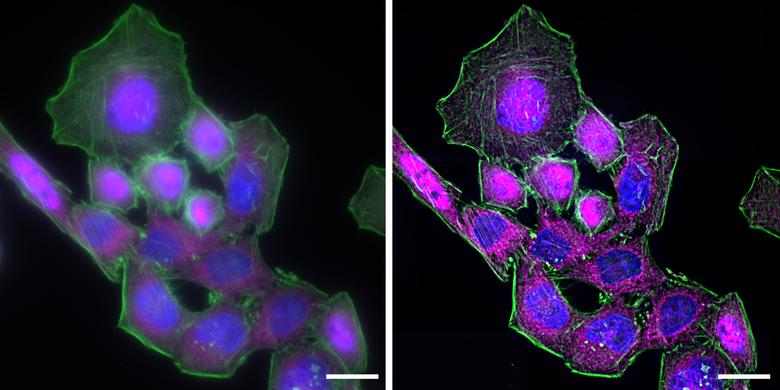Fluorescence microscopy is an essential tool in the biological and biomedical sciences, as well as other fields, due to attributes over and above those in available with traditional optical microscopy.
Fluorescence Microscopy is built around the same basic concept as brightfield, however, fluorescence and phosphorescence is used for illumination of light reaching the sample. The technique involves illumination with light of a specific wavelength matching absorption by fluorophores in the sample, thereby causing them to emit (or reflect) light back at a longer (lower energy) wavelength. Illumination is typically performed using a xenon arc lamp or mercury-vapor lamp, although again LEDs and lasers are gaining in popularity. Incident and emitted light are separated by a spectral emissions filter.
Epifluorescence microscopes are very common in the life sciences, with illuminated light and emitted light both passing through the sample objective. This arrangement allows high signal-to-noise, as the reflected light is filtered from the objective. This same concept is used in more advanced microscope technologies such as Confocal and Total Internal Reflectance (TIRF).
Although many substances auto-fluoresce, there are many commercially available fluorophores, with well-defined excitation and emission spectra, which can be used to 'stain' specific structures or molecules in a specimen. The strategic choice of fluorophores allows the identification of multiple targets as long as emission spectra can be cleanly separated and distinguished from auto-fluorescence.
Fluorescence imaging allows molecules beyond the resolution limit of the light microscope to be visualized. It is a key technique in clinical diagnostic and research environments in fields including: immunology, pathology, microbiology, genetics, and many others. Confocal fluorescence microscopy, in particular, has become an essential tool central to the study of structural and molecular dynamics in living cells. Fluorescence enables imaging techniques such as TIRF, FRET, FLIM, FLIP and FRAP. Fluorescence microscopy is also important for identifying fluorescent minerals, contaminants and impurities in materials science, geology, semiconductor inspection, and environmental protection.

Immunofluorescent imaging of HeLa cells is shown here, involving cells stimulated with LPS and subsequently immunolabeled for NF-κ B (magenta), actin filaments (green), and the nucleus (blue). Scale bar = 20 μm. All images were taken on a Leica DMi8 inverted microscope and imaged using a Leica HC PL APO CS2 63×/1.40 oil objective. Blind deconvolution was executed with the AutoQuant algorithm embedded in the Leica Application Suite X (LAS X) imaging software. (Credit Leica-microsystems science-lab; image originally published in Microscopy Today, Volume 24, Issue 06, November 2016, pp 38-45.)
Deconvolution helps to exclude out-of-focus information. A widefield microscope does not only detect light in the focus plane but also, for example, scattered light coming from other regions. A deconvolution software algorithm can help to redirect fluorescent signals to their origin. The left image shows the original widefield image, the right image has been subjected to deconvolution. Compared to the original, the deconvoluted image shows sharper details while still keeping quantitative data, and as a result, the position of the NF-κB molecules can be determined more precisely.
Beyond discussing the multitude of fluorescence techniques and applications, for the sake of time we will move on to instrument platforms, accessories, and add-ons in subsequent articles.
Read on in the following posts:
Brightfield Light Microscopy: Technical Insights and Applications
Progress in 3-D Imaging Microscopy and Brain Mapping
Immunoreagents and Emerging Applications in High-Resolution Imaging and Microscopy
Forging the Path of the Imaging Resolution Revolution
Ultra-High Resolution Imaging: The New Benchmark in Molecular Microscopy
Article updated June 30, 2020










